Analysis of Potential Evapotranspiration in Heilongjiang Province
Abstract
:1. Introduction
2. Study Area and Data Processing
3. Materials and Methods
3.1. Trend Analysis Using the Mann–Kendall (M–K) Test
3.2. Analysis of Trend Causes
4. Results and Discussion
4.1. PET Trends
4.2. Trends in Meteorological Factors
5. Conclusions
Author Contributions
Funding
Institutional Review Board Statement
Informed Consent Statement
Data Availability Statement
Acknowledgments
Conflicts of Interest
References
- Zhu, W.B.; Tang, W.X. Review of hierarchical models and optimization algorithms for large-scale surface water-groundwater systems. Hohai Sci. Technol. Prog. 1994, 1, 42–49. (In Chinese) [Google Scholar]
- Roderick, M.L.; Farquhar, G.D. The cause of decreased pan evaporation over the past 50 years. Science 2002, 298, 1410–1411. [Google Scholar] [CrossRef]
- Peterson, T.C.; Golubev, V.S.; Groisman, P.Y. Evaporation losing its strength. Nature 1995, 377, 687–688. [Google Scholar] [CrossRef]
- Quintana-Gomez, R. Changes in evaporation patterns detected in northernmost South America: Homogeneity testing. In Proceedings of the 7th International Meeting on Statistical Climatology, Whisler, BC, Canada, 25–29 May 1998; pp. 25–29. [Google Scholar]
- Moonen, A.C.; Ercoli, L.; Mariotti, M.; Masoni, A. Climate change in Italy indicated by agrometeorological indices over 122 years. Agric. For. Meteorol. 2002, 111, 13–27. [Google Scholar] [CrossRef]
- Chattopadhyay, N.; Hulme, M.; Leclerc, M.Y. Evaporation and potential evapotranspiration in India under conditions of recent and future climate change. Agric. For. Meteorol. 1997, 87, 55–73. [Google Scholar] [CrossRef]
- Roderick, M.L.; Farquhar, G.D. Changes in Australian pan evaporation from 1970 to 2002. Int. J. Climatol. 2004, 24, 1077–1090. [Google Scholar] [CrossRef]
- Cohen, S.; Ianetz, A.; Stanhill, G. Evaporative climate changes at Bet Dagan, Israel, 1964–1998. Agric. For. Meteorol. 2002, 111, 83–91. [Google Scholar] [CrossRef]
- Roderick, M.L.; Farquhar, G.D. Changes in New Zealand pan evaporation since the 1970s. Int. J. Climatol. 2005, 25, 2031–2039. [Google Scholar] [CrossRef]
- Wang, Y.J.; Jiang, T.; Xu, C.Y. Spatiotemporal variation in the evaporation capacity of 20 cm evaporation pans in the Yangtze River Basin. Adv. Water Sci. 2006, 17, 830–833. (In Chinese) [Google Scholar]
- Du, J.; Hu, J.; Liu, Y.L.; Bao, J.H.; Ba, L. Changes in the evaporation capacity of evaporation pan and their influencing factors in the middle reaches of the Brahmaputra River in the past 25 years. J. Nat. Resour. 2008, 23, 120–126. (In Chinese) [Google Scholar]
- Zhang, M.J.; Li, R.X.; Jia, W.X.; Wang, X.W. Spatial and temporal variation in potential evaporation in the Tianshan Mountains of China. J. Geogr. 2009, 64, 798–806. (In Chinese) [Google Scholar]
- Wang, Y.J.; Jiang, T.; Xu, C.Y. The changing trend of evaporation capacity and influencing factors in the Yangtze River Basin. J. Nat. Resour. 2005, 6, 70–76. (In Chinese) [Google Scholar]
- Du, J.; Bian, D.; Bao, J.H.; Ba, L.; Lu, Y.H. Characteristics of the evaporation capacity and the influencing factors. Adv. Water Sci. 2008, 19, 786–791. (In Chinese) [Google Scholar]
- Qi, T.; Zhang, Q.; Wang, Y.; Ba, L.; Lu, H.Y. Analysis of the changing trend of evaporation capacity in China from 1960 to 2005. Geogr. Sci. 2015, 35, 1599–1606. (In Chinese) [Google Scholar]
- Zhu, J. Water surface evaporation analysis in Kuqa City. Water Conserv. Technol. Econ. 2021, 27, 94–98. (In Chinese) [Google Scholar]
- Shen, Y.B.; Zhao, Z.C.; Shi, G.Y. Recent research on the changes, impact factors and possible climate effects. Adv. Earth Sci. 2008, 9, 915–923. (In Chinese) [Google Scholar]
- Palmer, W.C. Meteorological Drought; Weather Bureau: Washington, DC, USA, 1965. [Google Scholar]
- Seneviratne, S.I.; Nicholls, N.; Easterling, D.; Goodess, C.; Kanae, S.; Kossin, J.; Luo, Y.; Marengo, J.; McInnes, K.; Rahimi, M. Changes in climate extremes and their impacts on the natural physical environment. In Managing the Risks of Extreme Events and Disasters to Advance Climate Change Adaptation; Raineri Bernai, R., Ed.; Cambridge University Press: Cambridge, UK, 2012; pp. 109–230. [Google Scholar]
- Maliva, R.; Missimer, T. Aridity and drought. In Arid Lands Water Evaluation and Management; Rod, A., Ulrich, F., Wim, S., Eds.; Springer: Berlin/Heidelberg, Germany, 2012; pp. 21–39. [Google Scholar]
- Thornthwaite, C.W. An approach toward a rational classification of climate. Geogr. Rev. 1948, 38, 55–94. [Google Scholar] [CrossRef]
- Rayner, D.P. Wind run changes: The dominant factor affecting pan evaporation trends in Australia. J. Clim. 2007, 20, 3379–3394. [Google Scholar] [CrossRef]
- Hao, Z.; Song, J.; Xing, R.; Liu, W. Analysis of the change characteristics of meteorological elements in Heilongjiang Province. J. Chongqing Jiaotong Univ. 2016, 35, 93–99. (In Chinese) [Google Scholar]
- Mahdian, M.; Hosseinzadeh, M.; Siadatmousavi, S.M.; Chalipa, Z.; Delavar, M.; Guo, M.; Abolfathi, S.; Noori, R. Modelling impacts of climate change and anthropogenic activities on inflows and sediment loads of wetlands: Case study of the Anzali wetland. Sci. Rep. 2023, 13, 5399. [Google Scholar] [CrossRef]
- Malekmohammadi, B.; Uvo, C.B.; Moghadam, N.T.; Noori, R.; Abolfathi, S. Environmental Risk Assessment of Wetland Ecosystems Using Bayesian Belief Networks. Hydrology 2023, 10, 16. [Google Scholar] [CrossRef]
- Khosravi, K.; Rezaie, F.; Cooper, J.R.; Kalantari, Z.; Abolfathi, S.; Hatamiafkoueieh, J. Soil water erosion susceptibility assessment using deep learning algorithms. J. Hydrol. 2023, 618, 129229. [Google Scholar] [CrossRef]
- Chen, X.; Hu, Q. Groundwater influence on soil moisture and surface evaporation. J. Hydrol. 2004, 297, 285–300. [Google Scholar] [CrossRef]
- Chen, J.; Yang, F.; Tian, B.X.; Sun, Y.S. Analysis of the spatial and temporal variation of air temperature in the black soil area of Heilongjiang Province in the past 50 years. Res. Soil Water Conserv. 2013, 20, 150–154. (In Chinese) [Google Scholar]
- Ji, S.; Zhang, D.; Song, W. Preliminary study on snow cover and snowmelt runoff in Heilongjiang Province. Heilongjiang Water Spec. J. 1994, 3, 7–17. (In Chinese) [Google Scholar] [CrossRef]
- Han, R.; Li, W.; Ai, W.X.; Song, Y.L.; Ye, D.X. Date variation of primary frost in northern China and its impact on agriculture. J. Geogr. 2010, 65, 525–532. (In Chinese) [Google Scholar]
- Liu, Z.; Yang, X.; Wang, W.F.; Li, K.N.; Zhang, X.Y. Characteristics of agricultural climate resources change in the three provinces in Northeast China under the background of climate change. J. Appl. Ecol. 2009, 20, 2199–2206. (In Chinese) [Google Scholar]
- Li, K.; Yang, Z.; Liu, Z.; Wang, W.F.; Chen, F. Analysis of the possible impact of global climate change on China’s planting system. Characteristics of climate resources change and their possible influence on planting system boundaries in northern China. Agric. Sci. China 2010, 43, 2088–2097. (In Chinese) [Google Scholar]
- Gao, Y.; Na, J.H.; Gu, H.; Sun, S.J.; Dong, J. Analysis of climate change characteristics in Heilongjiang Province. J. Northeast. For. Univ. 2007, 5, 47–50. (In Chinese) [Google Scholar]
- Wang, X.; Yang, Y.; You, F. Analysis of climate change characteristics in Heilongjiang Province in the past 30 years. Chin. J. Agrometeorol. 2011, 32, 28–32. (In Chinese) [Google Scholar]
- Wang, Y.; Chen, L.; Li, Y.; Chen, S. Climate characteristics of cold wave in Heilongjiang Province from 1961 to 2012. J. Meteorol. Environ. 2014, 30, 125–130. (In Chinese) [Google Scholar]
- Sun, S.; Gao, Y.; Pei, Y.H.; Zhu, H.R.; Wang, C.L. Changes in climate mean value in Heilongjiang Province from 1981 to 2010 and its impact on climate assessment. Heilongjiang Meteorol. 2014, 31, 1–3. (In Chinese) [Google Scholar]
- He, R.; Jin, H.; Chang, X.; Lv, Z.L.; Yu, S.P. Analysis on the degradation status and causes of permafrost in the north of Northeast China. Ice 2009, 31, 829–834. (In Chinese) [Google Scholar]
- Peng, S.Z.; Ding, Y.X.; Wen, Z.M.; Chen, Y.M.; Cao, Y.; Ren, J.Y. Spatiotemporal change and trend analysis of potential evapotranspiration over the Loess Plateau of China during 2011–2100. Agric. For. Meteorol. 2017, 233, 183–194. [Google Scholar] [CrossRef]
- Mann, H.B. Non-parametric tests against trend. Econometrica 1945, 13, 245–259. [Google Scholar] [CrossRef]
- Kendall, M.G. Rank Correlation Measures; Charles Griffin: London, UK, 1975. [Google Scholar]
- Song, X.; Mu, X.; Gao, P.; Wang, S.Y.; Wang, F. The runoff changing trend of Songhua River Harbin Station in the past 100 years. J. Nat. Resour. 2009, 24, 1803–1809. (In Chinese) [Google Scholar]
- Sharma, S.; Saha, A.K. Statistical analysis of rainfall trends over Damodar River basin, India. Arab. J. Geosci. 2017, 10, 319. [Google Scholar] [CrossRef]
- Yin, Y.H.; Wu, S.H.; Zheng, D.; Yang, Q.Y. Regional differences in dry and wet conditions in China in the past 30 years. Chin. Sci. Bull. 2005, 50, 1636–1642. (In Chinese) [Google Scholar]
- Li, X.; Jiang, L.; Li, X.; Zhao, F.; Zhu, H.X. Evolution characteristics of evaporation in Heilongjiang Province from 1961 to 2017. Meteorology 2021, 47, 755–766. (In Chinese) [Google Scholar]
- Jin, L.Y.; Li, J.; Wang, X.; Chen, F.H. The temporal and spatial distribution of surface dry-wet conditions over northwestern China in recent 50 years. Acta Geogr. Sin. 2004, 59, 847–854. [Google Scholar]
- Wu, S.H.; Yin, Y.P.; Zheng, D.; Yang, Q.Y. Climate changes in the Tibetan Plateau during the three decades. Acta Geogr. Sin. 2005, 60, 3–11. [Google Scholar]
- Ma, X.; Zhang, M.; Wang, S.; Ma, Q.; Pan, S.K. Discussion on “evaporation paradox” in the Yellow River Basin. Acta Geogr. Sin. 2012, 67, 645–656. (In Chinese) [Google Scholar]
- Shen, S.; Sheng, Q. Characteristics and causes of pan evaporation in China in the past 45 years. J. Meteorol. 2008, 3, 452–460. (In Chinese) [Google Scholar]
- Zhu, H.; Liu, H.; Zhang, H.; Yin, C.J. Climate change characteristics of evaporation in Heilongjiang Province from 1971 to 2010. J. Meteorol. Environ. 2013, 29, 63–68. (In Chinese) [Google Scholar]
- Zeng, Y.; Qiu, X.; Liu, C.; Pan, A.D.; Gao, P. Climate change characteristics of pan evaporation in China during 1960–2000. Prog. Water Sci. 2007, 3, 311–318. (In Chinese) [Google Scholar]
- Qiu, X.; Liu, C.; Zeng, Y. Climate change characteristics of pan evaporation in the Yellow River Basin in recent 40 years. J. Nat. Resour. 2003, 4, 437–442. (In Chinese) [Google Scholar]
- Allen, M.R.; Ingram, W.J. Constraints on future changes in climate and the hydrologic cycle. Nature 2002, 419, 224–228. [Google Scholar] [CrossRef] [PubMed]
- Wang, Y.; Liu, B.; Zhai, J.; Su, B.D.; Luo, Y. The relationship between potential evaporation and actual evaporation in the Yangtze River basin. Adv. Clim. Change Res. 2011, 7, 393–399. (In Chinese) [Google Scholar]
- Brutsaert, W.; Parlange, M.B. Hydrologic cycle explains the evaporation paradox. Nature 1998, 396, 30. [Google Scholar] [CrossRef]
- Budyko, M.I. The Heat Balance of the Earth’s Surface; Weather Bureau, US Department of Commerce: Washington, DC, USA, 1958; 259p. [Google Scholar]
- Golubev, V.S.; Lawrimore, J.H.; Groisman, P.Y.; Speranskaya, N.A.; Zhuravin, S.A.; Menne, M.J.; Peterson, T.C.; Malone, R.W. Evaporation changes over the contiguous United States and the former USSR: A reassessment. Geophys. Res. Lett. 2001, 28, 2665–2668. [Google Scholar] [CrossRef]
- Jaksa, W.T.; Sridhar, V.; Huntington, J.L.; Khanal, M. Evaluation of the Complementary Relationship Using Noah Land Surface Model and North American Regional Reanalysis (NARR) Data to Estimate Evapotranspiration in Semiarid Ecosystems. J. Hydrometeotol. 2013, 14, 345–359. [Google Scholar] [CrossRef]
- Teuling, A.J.; Hirschi, M.; Ohmura, A.; Wild, M.; Reichstein, M.; Ciais, P.; Buchmann, N.; Ammann, C.; Montagnani, L.; Richardson, A.D.; et al. A regional perspective on trends in continental evaporation. Geophys. Res. Lett. 2009, 36, L02404. [Google Scholar] [CrossRef]
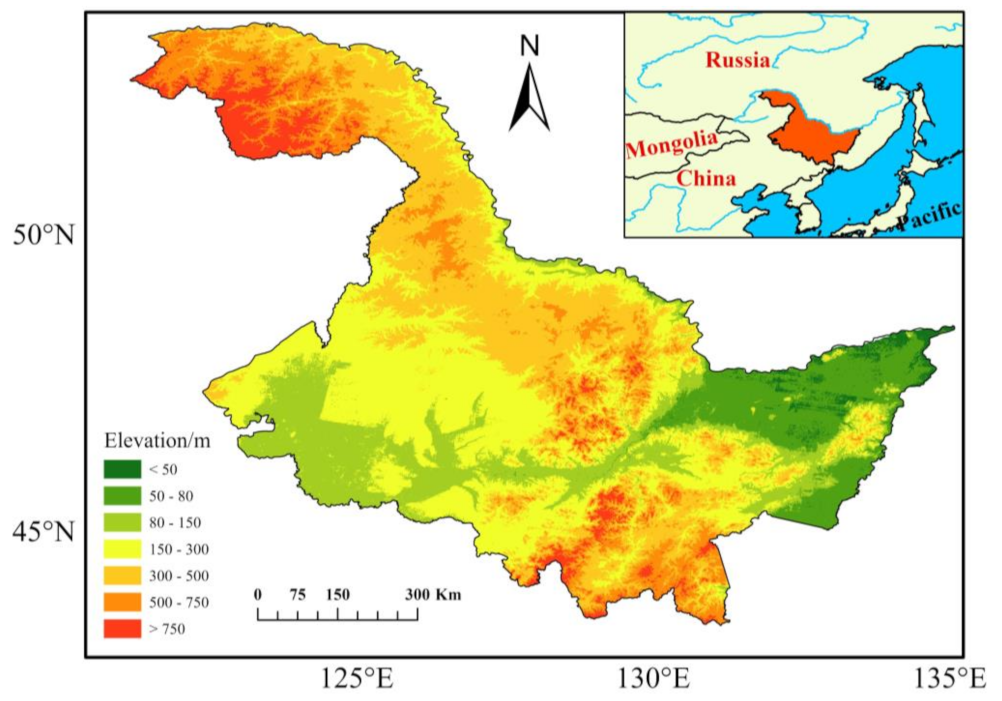
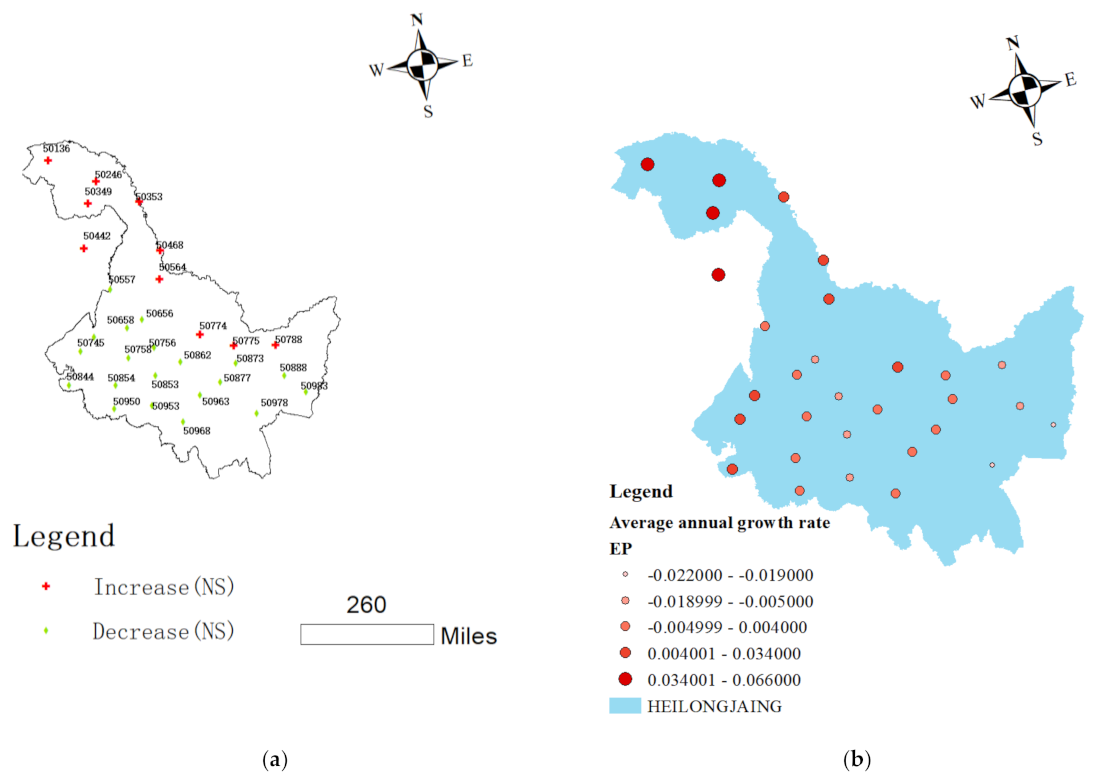
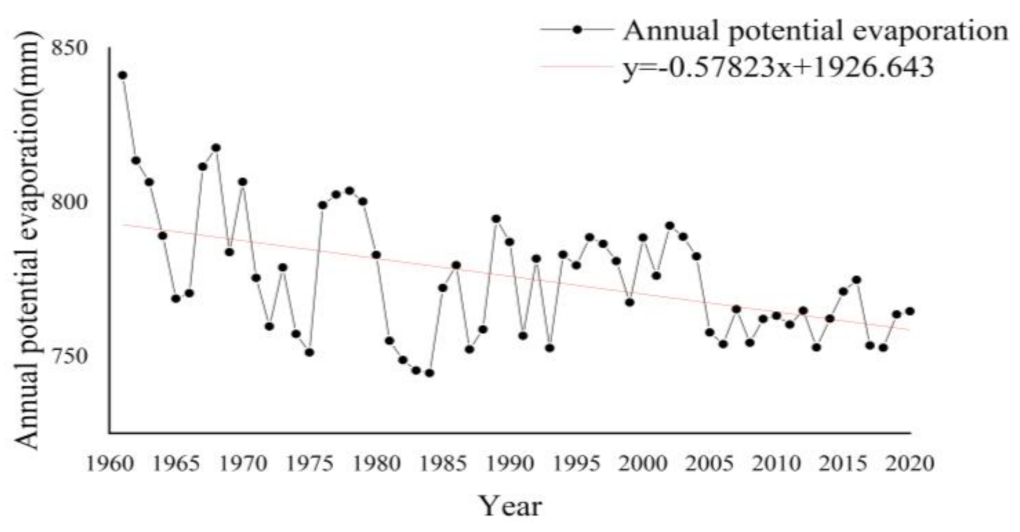


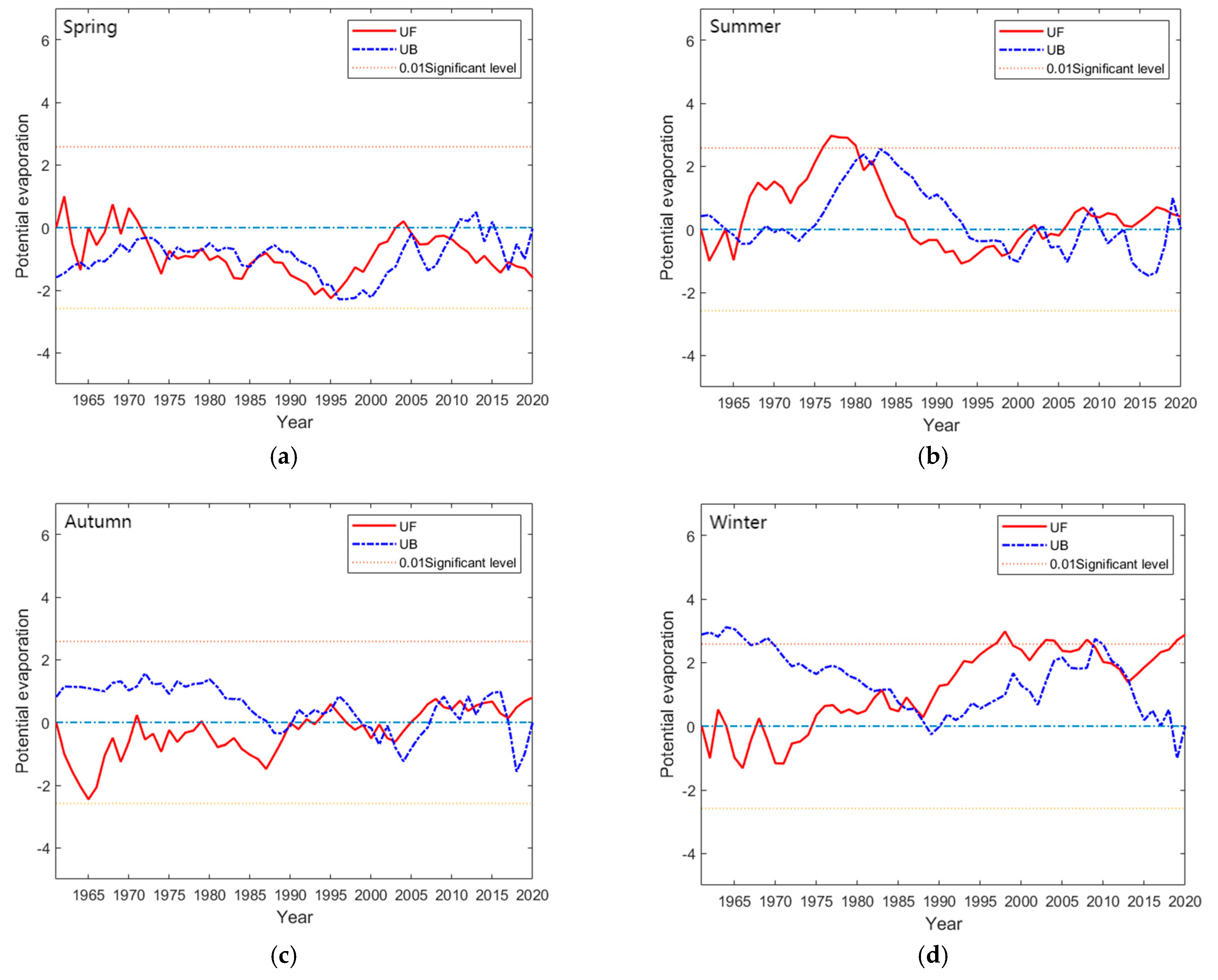
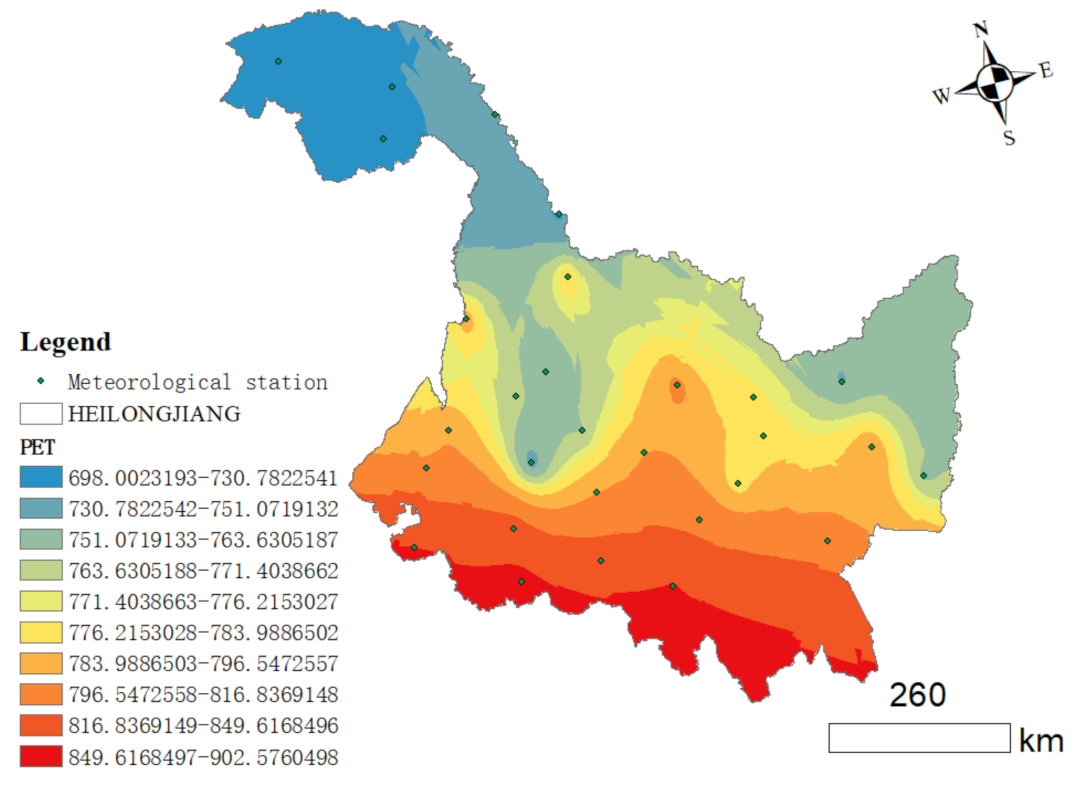
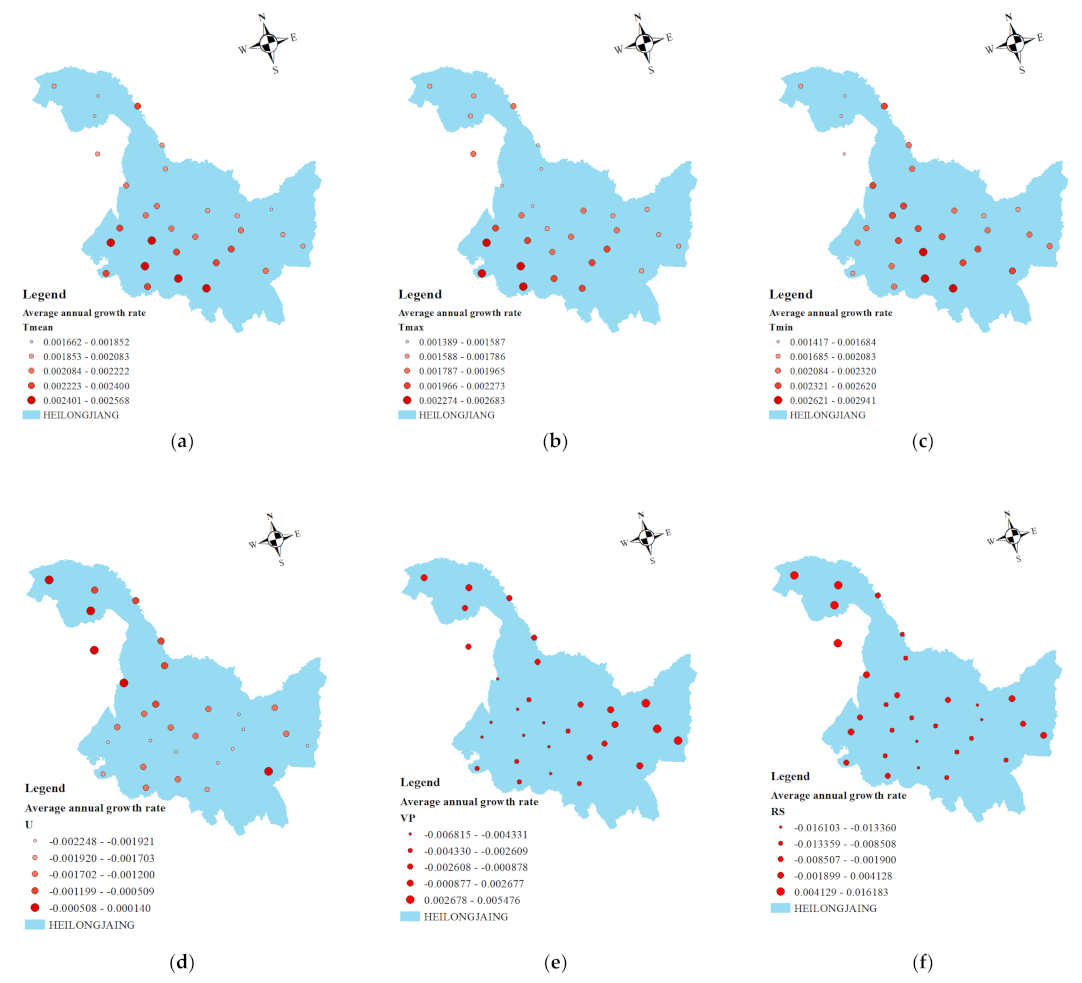
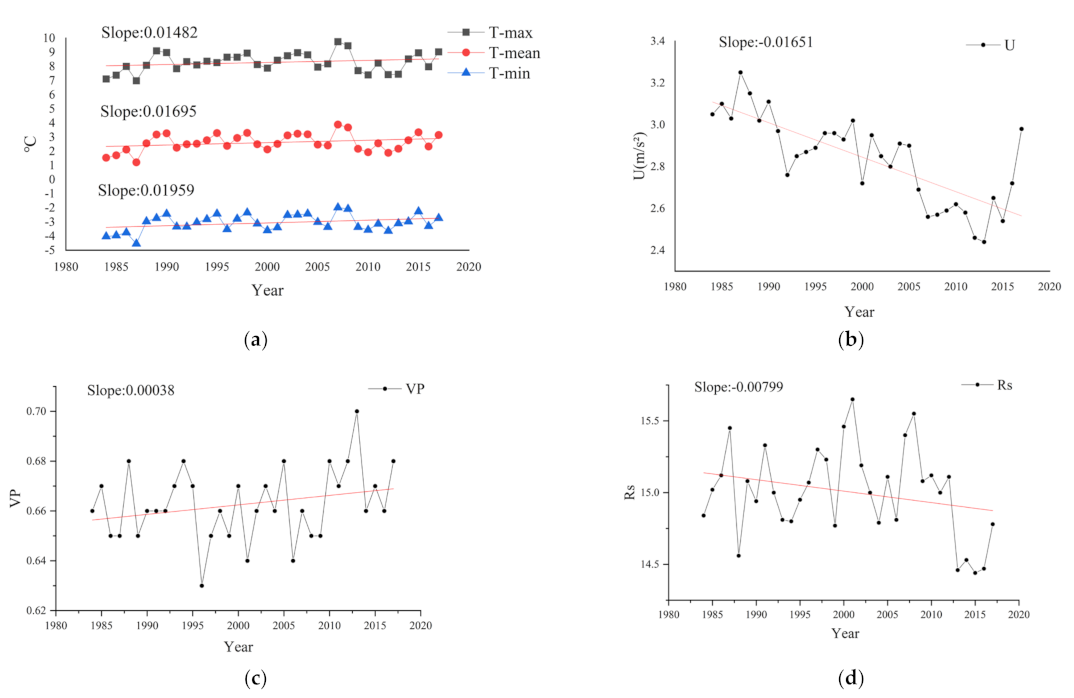


| Year | T-Min (°C) | T-Mean (°C) | T-Max (°C) | U (m/s2) | VP (%) | Rs (w/m2) |
|---|---|---|---|---|---|---|
| 1985–1994 | −3.288 | 2.412 | 8.117 | 3.011 | 0.663 | 15.011 |
| 1995–2004 | −2.859 | 2.862 | 8.55 | 2.899 | 0.656 | 15.141 |
| 2005–2014 | −3.019 | 2.596 | 8.208 | 2.606 | 0.667 | 15.017 |
| Speed/10 a | 0.1345 | 0.092 | 0.0455 | −0.2025 | 0.002 | −0.003 |
| Slope | 0.01959 | 0.01695 | 0.01482 | −0.01651 | 0.00038 | −0.00799 |
| Meteorological Factor | Intercept | Standard Error | T | P | Contribution Rate (%) |
|---|---|---|---|---|---|
| T-min | −79.38 | 0.013 | 1.2 | 0.02 | −87.23 |
| T-mean | 79.02 | 0.031 | 1.6 | 0.03 | |
| T-max | 16.52 | 0.022 | 1.5 | 0.01 | |
| U | −13.72 | 0.017 | 1.9 | 0.01 | 88.25 |
| VP | 238.58 | 0.063 | −1.7 | 0.06 | 65.87 |
| Rs | 12.14 | 0.092 | −1.5 | 0.15 | 42.53 |
Disclaimer/Publisher’s Note: The statements, opinions and data contained in all publications are solely those of the individual author(s) and contributor(s) and not of MDPI and/or the editor(s). MDPI and/or the editor(s) disclaim responsibility for any injury to people or property resulting from any ideas, methods, instructions or products referred to in the content. |
© 2023 by the authors. Licensee MDPI, Basel, Switzerland. This article is an open access article distributed under the terms and conditions of the Creative Commons Attribution (CC BY) license (https://creativecommons.org/licenses/by/4.0/).
Share and Cite
Su, Q.; Dai, C.; Zhang, Q.; Zhou, Y. Analysis of Potential Evapotranspiration in Heilongjiang Province. Sustainability 2023, 15, 15374. https://doi.org/10.3390/su152115374
Su Q, Dai C, Zhang Q, Zhou Y. Analysis of Potential Evapotranspiration in Heilongjiang Province. Sustainability. 2023; 15(21):15374. https://doi.org/10.3390/su152115374
Chicago/Turabian StyleSu, Quanchong, Changlei Dai, Qingsong Zhang, and Yang Zhou. 2023. "Analysis of Potential Evapotranspiration in Heilongjiang Province" Sustainability 15, no. 21: 15374. https://doi.org/10.3390/su152115374
APA StyleSu, Q., Dai, C., Zhang, Q., & Zhou, Y. (2023). Analysis of Potential Evapotranspiration in Heilongjiang Province. Sustainability, 15(21), 15374. https://doi.org/10.3390/su152115374






